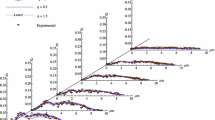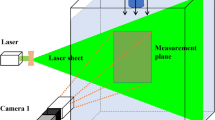Abstract
The majority of scientific and industrial electrical spray applications make use of sprays that contain a range of drop diameters. Indirect evidence suggests the mean drop diameter and the mean drop charge level are usually correlated. In addition, within each drop diameter class there is every reason to suspect a distribution of charge levels exist for a particular drop diameter class. This paper presents an experimental method that uses the joint PDF of drop velocity and diameter, obtained from phase Doppler anemometry measurements, and directly obtained spatially resolved distributions of the mass and charge flux to obtain a drop diameter and charge frequency distribution. The method is demonstrated using several data-sets obtained from experimental measurements of steady poly-disperse sprays of an electrically insulating liquid produced with the charge injection technique. The space charge repulsion in the spray plume produces a hollow cone spray structure. In addition an approximate self-similarity is observed, with the maximum radial mass and charge flow occurring at r/d ~ 200. The charge flux profile is slightly offset from the mass flux profile, and this gives direct evidence that the spray specific charge increases from approximately 20% of the bulk mean spray specific charge on the spray axis to approximately 200% of the bulk mean specific charge in the periphery of the spray. The results from the drop charge estimation model suggest a complex picture of the correlation between drop charge and drop diameter, with spray specific charge, injection velocity and orifice diameter all contributing to the shape of the drop diameter–charge distribution. Mean drop charge as a function of the Rayleigh limit is approximately 0.2, and is invariant with drop diameter and also across the spray cases tested.









Similar content being viewed by others
Abbreviations
- U, V:
-
Instantaneous drop axial and radial velocity
- z, r:
-
Axial and radial displacement from the spray origin
- U r :
-
Instantaneous relative speed between drop and continuum
- \( \overline{U}_{\text{inj}} \) :
-
Mean injection velocity at the atomizer orifice
- d :
-
Orifice diameter
- \( \overline{Q}_{V} \) :
-
Mean spray specific charge
- \(U_{\text{f}}^* \) :
-
Fluid velocity viewed by the particle
- f D :
-
Correction term for non-Stokesian drag force
- D :
-
Particle diameter
- μ f :
-
Fluid dynamic viscosity
- m :
-
Particle mass
- Q :
-
Particle charge
- E*:
-
Electrical field viewed by the particle
- ρ f :
-
Fluid density
- ρ :
-
Particle density
References
Bankston CP, Back LH, Kwack EY, Kelly AJ (1988) Experimental investigation of electrostatic dispersion and combustion of diesel fuel jets. J Eng Gas Turbine Power 110:361–368
Bellan J, Harstad K (1996) Electrostatic dispersion and evaporation of clusters of drops of high-energy fuel for soot control. In: Proceedings of 26th international symposium of combustion, pp 1713–1722
Chang JS, Kelly AJ, Crowley JM (1995) Handbook of electrostatic processes. Marcel Dekker, New York
Gomez A, Tang K (1994) On the structure of an electrostatic spray of monodisperse droplets. Phys Fluids 6:2317–2332
Hanselman D, Littlefield B (2001) Mastering MATLAB 6: a comprehensive tutorial and reference. Prentice Hall, New Jersey
Hardalupas Y (1989) Experiments with isothermal two-phase flows. Ph.D. thesis, Imperial College London
Hardalupas Y, Laker J (1993). Description of the thermofluids section ‘Model 3’ phase Doppler counter. Mechanical Engineering Department, Report TF/93/15, Imperial College London
Hardalupas Y, Taylor AMKP (1989) On the measurement of the particle concentration near a stagnation point. Exp Fluids 8:113–118
Kelly AJ (1984) The electrostatic atomization of hydrocarbons. J Inst Energy 57:312–321
Kim JH, Nakajima T (1999) Aerodynamic influences on droplet atomization in an electrostatic spray. JSME Int J Series B 42:224–229
Kulon J, Malyan BE, Balachandran W (2003) Simultaneous measurement of particle size and electrostatic charge distribution in DC electric field using phase Doppler anemometry. IEEE Trans IA 39(5):1522–1528
Law SE (2001) Agricultural electrostatic spray application: a review of significant research and development during the 20th century. J Electrostat 51–52:25–42
Leuteritz U, Velji A, Bach E (2000) A novel injection system for combustion engines based on electrostatic fuel atomization. In: Proceedings of SAE International Spring Fuels and Lubricants Meeting and Exposition, Paris, France
Matthews GA (1992) Pesticide application methods, 2nd edn. Longman Science and Technology, London
Polat M, Polat H, Chander S (2000) Electrostatic charge on spray droplets of aqueous surfactant solutions. J Aerosol Sci 31(5):551–562
Rayleigh L (1882) On the equilibrium of liquid conducting masses charged with electricity. Phil Mag 14:184–186
Rigit ARH, Shrimpton JS (2006a) Electrical performance of charge injection atomizers. Atomization Sprays 16(4):401–419
Rigit ARH, Shrimpton JS (2006b) Spray characteristics of charge injection electrostatic atomizers with small orifice diameters. Atomization Sprays 16(4):421–442
Schwar MJR, Weinburg FJ (1971) The measurement of velocity by applying Schlieren-interferometry to Doppler-shifted light. Proc Roy Soc Lond A 311(1506):469–476
Shrimpton JS, Yule AJ (1998) Drop size and velocity measurements in an electrostatically produced hydrocarbon spray. J Fluids Eng Trans ASME 120(3):580–585
Shrimpton JS, Yule AJ (1999) Characterization of charged hydrocarbon sprays for application in combustion systems. Exp Fluids 26:460–469
Shrimpton JS, Yule AJ (2001) Atomization, combustion and control of charged hydrocarbon sprays. Atomization Sprays 11:365–396
Shrimpton JS, Yule AJ, Watkins AP, Balachandran W, Hu D (1995) Electrostatically atomized hydrocarbon sprays. Fuel 74:1094–1103
Ye Q, Steigleder, Scheibe A, Domnick J (2002) Numerical simulation of the electrostatic powder coating process with a corona spray gun. J Electrostat 54(2):189–205
Author information
Authors and Affiliations
Corresponding author
Appendix A: PDA annular flow rate measurement and flux calculation accuracy
Appendix A: PDA annular flow rate measurement and flux calculation accuracy
The calculation method for the mass flux from the PDA measurement data is now described in detail since an error exists in the original reference (Hardalupas and Taylor 1989; Hardalupas and Laker 1993), and the issue of mass flux measurement accuracy is of critical importance in the present contribution.
The effective area A i of the measurement volume (MV) for the ith drop size class as described by Hardalupas and Taylor (1989) is defined and corrected here as
in μm2, where θ is the beam intersection angle (in degree) at the measurement volume, u shift (in m/s) is the Doppler shift velocity, u i (t) is the instantaneous drop velocity (in m/s), z p is the known length (in μm) of the image of the spatial slit incorporated in the receiving unit, b y is the Gaussian waist diameter (in μm) at the intersection region, N 0 and N f is the number of zero crossing and the number of fringes in MV respectively, and and n i is the number of drop in the ith size class. The value of z p = 625 μm, θ/2 = 1.289° and N f = 7 are given in Table 1. The minimum number of zero crossing N 0 = 9 was used in the PDA measurement for validating a Doppler burst. The Gaussian waist diameter b y = N f N x /cos(θ/2) ≈ 80 μm, where N x = 11.44 μm is the fringe spacing. The variable <x i > is the average length (in μm) of MV normal to fringes (Hardalupas and Taylor 1989) and defined as
where t n is the residence time (in μs) and u n is the velocity (in m/s) of the nth drop in the ith size class. By knowing the effective area A i of MV for each drop size class, the mass flux for each of the ith size class can be calculated with the following equation (Hardalupas 1989)
in kg/m2 s, where T s is the total sampling time (in μs), ρ is the liquid density (in kg/m3) and D i is the mean diameter (in μm) of the ith drop size class. The mass flow rate from the PDA measurement for the ith size class passing through the rth annulus is therefore
in kg/s, where S r is the area (in μm2) of the rth annulus normal to the axial velocity component. Hence, the total mass flow rate for all drop size classes of the rth annuli is
and the total mass flow rate from all rings and all drop size classes of the spray derived from the PDA measurement is simply
By correcting the PDA annular mass flow rate, Eq. 5, with the measured mass flow rate from the flow meter, \( \dot{m}_{F} , \) where we assume that the PDA mass flow measurements relative to each other are correct, and using \( \dot{m}_{F} \) as a normalizing parameter:
and for completeness, the corrected total mass flow is:
By using Eq. 8 to correct mass flux for the ith drop size class passing through the rth annulus, Eq. 3, and assuming the fluxes as a function of i and r are similarly relatively correct, the corrected mass flux per drop size class is
From Eq. 9, the corrected total mass flux for the rth annular is simply
The correction in Eq. 10 reflects the fact that not all drops are measured, which should lead to underestimation in calculating mass flux. The number of drop n i /n r for drop size class i, which is a relative quantity must be now converted and corrected to be the actual number of drops \( n_{r,i}^{\prime } \) based on the corrected mass flow rate \( \dot{m}_{P,r}^{\prime } \) passing through the rth annulus. By substituting Eq. 9 into 4, the corrected mass flow rate for the ith drop size class into the rth annulus may be rewritten as
where f r,i is the frequency (#/s) of the drop in the ith drop size class passing through the rth annulus, and m i is the mass of the drop defining the midpoint of the ith drop size class defined as
By substituting Eq. 12 into 11, the new relationship for f r,i is
Also, from the corrected annular mass flow rate, Eq. 7, the relationship
where \( n_{r,i}^{\prime } \) is the corrected total number (#) of drops in all size classes for the rth annular collected in time Δt (s). Substituting Eq. 12 into 14 and setting Δt = 1 s
in #/s. The corrected drop number flux \( n_{r,i}^{\prime } \) in #/m2 s, for the ith drop size class falling into the rth annulus may be obtained from Eq. 15 by multiplying \( n_{r,i}^{\prime } \) with n i /n r and dividing the product with the area of the annulus S r ,
The drop number flux \( n_{r,i}^{\prime } \) described here is therefore based on the mass flux \( \hat{G}_{r,i} \) as defined in Eq. 5, and the corrected total number flux into the rth annulus is
Rights and permissions
About this article
Cite this article
Rigit, A.R.H., Shrimpton, J.S. Estimation of the diameter–charge distribution in polydisperse electrically charged sprays of electrically insulating liquids. Exp Fluids 46, 1159–1171 (2009). https://doi.org/10.1007/s00348-009-0626-5
Received:
Revised:
Accepted:
Published:
Issue Date:
DOI: https://doi.org/10.1007/s00348-009-0626-5




